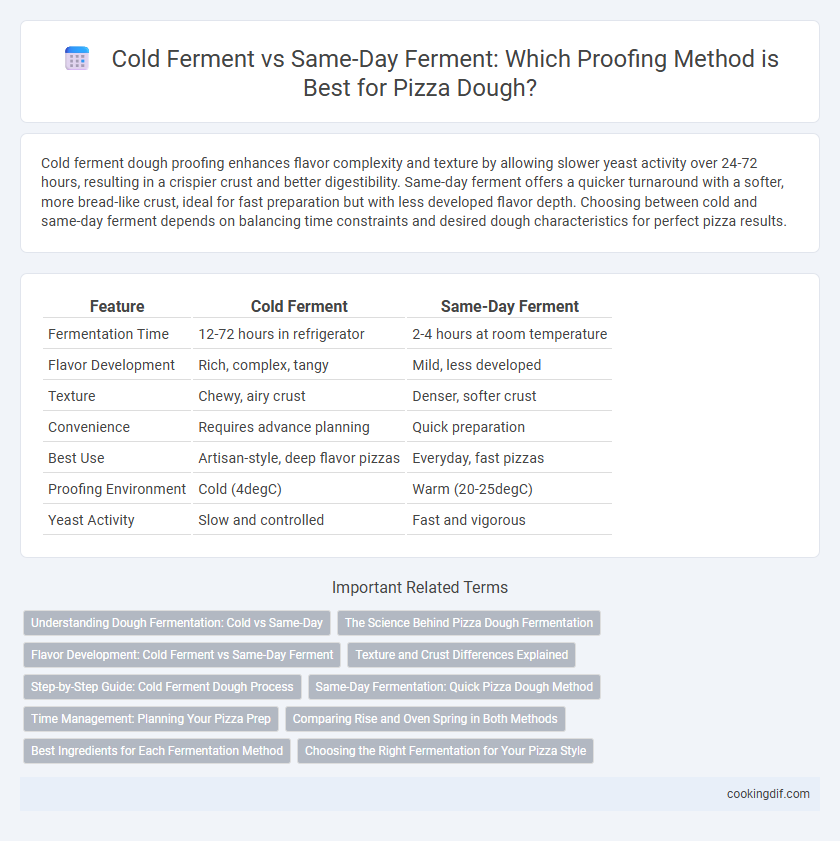Cold ferment dough proofing enhances flavor complexity and texture by allowing slower yeast activity over 24-72 hours, resulting in a crispier crust and better digestibility. Same-day ferment offers a quicker turnaround with a softer, more bread-like crust, ideal for fast preparation but with less developed flavor depth. Choosing between cold and same-day ferment depends on balancing time constraints and desired dough characteristics for perfect pizza results.
Table of Comparison
| Feature | Cold Ferment | Same-Day Ferment |
|---|---|---|
| Fermentation Time | 12-72 hours in refrigerator | 2-4 hours at room temperature |
| Flavor Development | Rich, complex, tangy | Mild, less developed |
| Texture | Chewy, airy crust | Denser, softer crust |
| Convenience | Requires advance planning | Quick preparation |
| Best Use | Artisan-style, deep flavor pizzas | Everyday, fast pizzas |
| Proofing Environment | Cold (4degC) | Warm (20-25degC) |
| Yeast Activity | Slow and controlled | Fast and vigorous |
Understanding Dough Fermentation: Cold vs Same-Day
Cold ferment dough undergoes slow fermentation in the refrigerator for 24 to 72 hours, allowing enzymes to break down starches and develop complex flavors and improved texture. Same-day ferment involves proofing the dough at room temperature for 1 to 4 hours, resulting in quicker gas production but less depth in flavor and chewiness. The extended enzymatic activity during cold fermentation enhances gluten structure and moisture retention, making it the preferred method for artisanal, flavorful pizza crusts.
The Science Behind Pizza Dough Fermentation
Cold fermenting pizza dough involves a slow fermentation process at low temperatures, typically between 2degC and 5degC, which allows yeast activity to produce complex flavors and improve gluten structure over 24 to 72 hours. Same-day fermenting, performed at room temperature around 21degC to 27degC, accelerates yeast fermentation, resulting in a quicker rise but less developed flavor and texture. The extended enzymatic activity during cold fermentation enhances sugar breakdown and gluten network formation, creating a chewier, more flavorful crust favored by artisanal pizza makers.
Flavor Development: Cold Ferment vs Same-Day Ferment
Cold ferment enhances flavor development by allowing enzymes and yeast to slowly break down starches and sugars over 24 to 72 hours, resulting in a more complex, tangy, and aromatic dough. Same-day ferment, typically completed within 2 to 4 hours, produces a milder flavor with less depth due to the faster fermentation process. Extended cold fermentation promotes the production of organic acids and alcohol, which contribute significantly to the dough's characteristic taste and texture.
Texture and Crust Differences Explained
Cold ferment dough undergoes a slow fermentation process in the refrigerator, enhancing gluten development and resulting in a chewier texture with a more complex, airy crumb structure. Same-day ferment produces a quicker rise, leading to a softer, less developed crust that is thinner and less chewy. The cold ferment method also creates a crisper crust due to prolonged enzymatic activity, while same-day fermentation often yields a breadier, tender crust texture.
Step-by-Step Guide: Cold Ferment Dough Process
Cold ferment dough proofing enhances flavor and texture by allowing yeast to slowly ferment in the refrigerator for 24 to 72 hours, developing complex aromas and a chewier crust. Begin by mixing flour, water, yeast, and salt, then knead the dough until smooth before placing it in a lightly oiled bowl, covered tightly. Refrigerate the dough, perform a gentle fold every 24 hours, then remove it an hour before baking to come to room temperature for optimal rise and bake quality.
Same-Day Fermentation: Quick Pizza Dough Method
Same-day fermentation accelerates dough proofing by allowing the yeast to develop flavor and texture within a few hours, typically 2 to 6 hours, ideal for quick pizza preparation. This method yields a lighter crust with moderate air bubbles, balancing convenience and quality without the extensive sourdough tang of cold ferment. Bakers seeking fast turnaround benefit from controlled temperature proofing around 75degF, ensuring consistent rise and optimal gluten development.
Time Management: Planning Your Pizza Prep
Cold ferment extends dough proofing over 24 to 72 hours in refrigeration, allowing flavors to develop deeply while offering flexible scheduling for pizza prep. Same-day ferment requires 2 to 4 hours at room temperature, speeding up production but demanding precise timing to avoid underproofing or overproofing. Efficient time management balances fermentation duration with desired dough texture and workflow, optimizing pizza quality and kitchen operations.
Comparing Rise and Oven Spring in Both Methods
Cold ferment dough undergoes a slow rise in the refrigerator, developing complex flavors and a more elastic texture due to extended yeast activity and enzyme breakdown. Same-day ferment typically results in a quicker rise with less flavor depth but produces a higher oven spring due to the dough's warmer temperature and active yeast during baking. The extended proofing time of cold fermentation enhances gluten structure, yielding a chewier crust, while same-day ferment offers a lighter, airier crumb with less fermentation-derived taste.
Best Ingredients for Each Fermentation Method
Cold ferment dough benefits from high-protein, bread flour that develops gluten slowly over extended fermentation, creating a complex flavor profile and chewy texture. Same-day ferment dough works best with all-purpose flour, combined with instant yeast and moderate hydration to speed up gluten formation and proofing time. Using filtered water and fine sea salt enhances yeast activity and balances flavor in both fermentation methods.
Choosing the Right Fermentation for Your Pizza Style
Cold ferment allows dough to develop complex flavors and a chewier texture through slow yeast activity at low temperatures over 24 to 72 hours, ideal for Neapolitan and artisan-style pizzas. Same-day fermenting, with proofing times of 2 to 4 hours at room temperature, produces a softer crust with a lighter texture, suitable for thin-crust and fast-paced pizza preparations. Selecting the right fermentation method depends on desired crust characteristics and preparation time, balancing flavor development and operational efficiency.
Cold ferment vs same-day ferment for dough proofing Infographic

 cookingdif.com
cookingdif.com